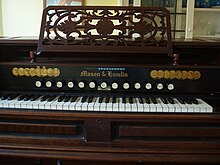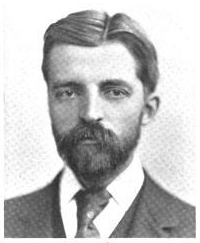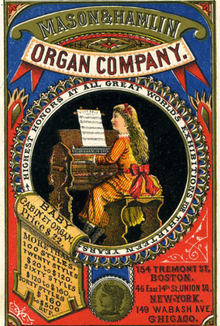Mason and Hamlin
| Mason and Hamlin | |
|---|---|
| legal form | Public company under US law |
| founding | 1854 |
| Seat | Haverhill, Mass., USA |
| Branch | Piano construction |
Mason & Hamlin is a piano manufacturer based in Haverhill , Massachusetts , USA.
history
19th century
Mason & Hamlin was founded in Boston , Massachusetts in 1854 . Founders were music teacher Henry Mason, son of Lowell Mason , the composer of the American national anthem, and Emmons Hamlin, a mechanic and inventor who worked for the organ and melodeon builder Prince & Co. in Buffalo , New York .
At first they only made melodeons, but from 1855 they also made regular suction wind harmoniums . The bellows were placed vertically under the tongues, which served as a model for all other suction wind harmoniums based on the "American system". In the early 1870s, they were considered the largest and most important manufacturer of suction wind harmoniums. The company employed around 500 people and built around 200 instruments per week. Mason & Hamlin supplied harmoniums to a number of well-known composers, especially Franz Liszt , whose name the company transferred to their patented prolongation mechanism (key head) as well as to a special series of harmonium models, the so-called "Liszt Organs".
Mason & Hamlin also began making piano in 1883. At first they built only upright pianos , which had a patented method of vocal attitude one screw stringer called, and an improved system over the traditional design with tuning pegs should be. In 1895 the piano manufacturing department was completely reorganized by Richard W. Gertz. Gertz was an independent German piano developer from Germany who had previously designed new scales for Mason & Hamlin. Gertz was appointed secretary (commercial director) of the company in 1903 and then became president in 1906. He had developed and patented the Tension Resonator for M&H , a device under the edges of the housing structure, by means of which the soundboard can be prevented from losing its curvature. This facility was found in grand pianos from 1900 onwards. The company states that this facility is currently found in all newly built Mason & Hamlin pianos.
20th century
At the turn of the 20th century, the “golden age” of piano making, well-known pianists were under contract with Mason and Hamlin, such as Sergei Rachmaninoff , whose recording of his Second Piano Concerto from 1924 was played on a Mason and Hamlin grand piano. The composer Maurice Ravel said of the Mason & Hamlin pianos: “While the qualities of the percussion instrument are preserved, the Mason & Hamlin piano also serves the composer's concept with its extraordinary dynamic range, as well as the quality of its tones. It's not far from a small orchestra. In my opinion the Mason & Hamlin is a real work of art. " Many piano lovers praise the pianos made by Mason & Hamlin at that time.
The Cable Company, a Chicago-based piano manufacturer, held a stake in Mason & Hamlin from 1904 to 1924 when it was sold to the American Piano Company . Mason & Hamlin's role in this group of companies was later described as an "artist brand". This group included Chickering and Sons ("Family Use") and Wm. Knabe & Co. ("Favorite of the Metropolitan Opera"). US piano sales began to decline in 1928, and after the collapse in the wake of the weak stock market in 1929, the Mason & Hamlin brand, piano and manufacturing equipment inventory were sold to American competitor Aeolian for $ 450,000. The factory buildings were sold separately at the end of the following year. In 1932, Mason & Hamlin became part of “Aeolian-American” when the two companies merged. The new brand brought together the shares of more than 20 piano manufacturers; Mason & Hamlin, which had meanwhile been made in the former Hallet, Davis & Company piano factory in Neponset , Massachusetts , were moved to another factory in the Aeolian-American complex in East Rochester , New York .
Piano manufacturing in the United States came to a standstill in 1942 under the sovereignty of the War Production Board due to World War II. The Mason & Hamlin manufacturing facility now produced gliders . Ownership of the Mason & Hamlin brand changed several times in the post-war era. It became part of Sohmer in 1985 . Over the decades, the design of M&H pianos has changed so much that they have almost nothing in common with the origins of the classic Mason & Hamlin pianos of the era before the economic crisis of 1929.
In 1989, Seattle-based businessman Bernard "Bud" Greer bought the Sohmer Company, which also owned the trademark rights to George Steck, Knabe, and Mason & Hamlin. He acquired the naming rights, the technical specifications and the manufacturing facilities. He had these things moved to a piano factory in Haverhill, Massachusetts, which he had previously bought from piano maker Santi Falcone - and from which he also held the Falcone manufacturing specifications and naming rights. Greer named the new company the Mason & Hamlin Companies . Greer's aim was to resurrect the Mason & Hamlin pianos from the pre-Depression era and return to the original specifications including Gertz's scale calculations and the use of similar materials. A few changes have been made, including the use of Renner mechanical parts and slightly longer buttons.
Between 1990 and 1994 almost 600 pianos were made, mostly the A and BB models, together with a few model 50 pianinos. Greer filed for bankruptcy in 1996. In 1995, Premier Pianos took over the management of the Haverhill factory and completed a number of pianos with a core team.
today
In 1996, Mason & Hamlin was bought by Burgett Inc., which also owns the PianoDisc system , a manufacturer of reproduction pianos of the same name. Mason & Hamlin pianos continue to be manufactured in Haverhill, Massachusetts and sold in the United States, Canada, Europe and Asia. Mason & Hamlin is a member of NAMM , the International Association of Musical Instrument Manufacturers , and PMAI (Piano Manufacturers Association International).
Tension resonator
Every Mason & Hamlin piano has a tension resonator , a system of steel struts under light tension that is anchored to the wooden structure of the underside of the case, under the cast iron frame and the strings. In wings, the struts extend from one or two stars. The struts are screwed at certain angles around the cabinet and the inner support of the soundboard . The 50-Pianino model has a strut that stretches between the two sides of the case. The manufacturer claims that these struts bring stability into the case, which in turn gives the "Krone" ("crown", in German mostly "Glocke"), i.e. H. the elevation or curvature of the soundboard on which the sound of a piano depends. It stands to reason that the added stability and tension required to maintain the bell has a direct effect on the ability of the case to reflect the sound of the soundboard and to increase the power and duration of the piano. Piano technicians report that old Mason & Hamlin pianos also keep their bells.
Current models
| model | Dimensions | Finishes |
|---|---|---|
|
Model-50
Vertical / pianino |
|
|
| A. |
|
|
| AA |
|
|
| B. |
|
|
| BB |
|
|
| CC-94 |
|
|
The models A and BB are also available as part of the “Monticello Art Case Collection”. The company also offers a high piano, the 50 "high Model 50. All Mason and Hamlin pianos are warranted for 12 years.
swell
- ^ A b "Cabinet and Parlor Organs" The Great Industries of the United States J. Burr & Hyde, Hartford. 1872 p. 109-121
- ^ Samuel Atkins Eliot A History of Cambridge, Massachusetts The Cambridge Tribune, Cambridge MA 1913. p. 297-298
- ^ A b Robert F. Gellerman The American Reed Organ and the Harmonium The Vestal Press, New York. 1996. p.19
- ^ "Improved Upright Pianos" The Manufacturer and Builder vol. 16, no.12, December 1884 p. 282-283
- ↑ Alfred Dolge Pianos and their Makers vol. 2, Covina Publishing Company, Covina CA. 1913. p. 144-150
- ↑ Piano Specifications ( Memento of the original from October 15, 2008 in the Internet Archive ) Info: The archive link was inserted automatically and has not yet been checked. Please check the original and archive link according to the instructions and then remove this notice. Mason & Hamlin website (accessed October 11, 2008)
- ↑ Archived copy ( memento of the original dated June 3, 2007 in the Internet Archive ) Info: The archive link was inserted automatically and has not yet been checked. Please check the original and archive link according to the instructions and then remove this notice.
- ↑ "History" ( Memento of the original from June 3, 2007 in the Internet Archive ) Info: The archive link was inserted automatically and has not yet been checked. Please check the original and archive link according to the instructions and then remove this notice. , Mason & Hamlin Official Website , 2007. Accessed June 2, 2007.
- ↑ a b Christine Merrick Ayars Contributions to the Art of Music in America by the Music Industries of Boston The HH Wilson Company, New York, 1937. p.127
- ^ A b "The American Piano Company" Harvard Business School case study, 1934, reproduced in the AMICA Bulletin and available from the Pianola Society
- ^ A b "Deals and Developments" Time Magazine Aug. 8, 1932
- ^ "Piano Glissando" Time Magazine, December 30, 1929
- ^ A b "Mason & Hamlin" , Grove Music Online , 2007. Accessed June 2, 2007. (Requires subscription).
- ↑ bookrags.com ( Memento from June 5, 2011 in the Internet Archive )
- ^ Fine, Larry. The Piano book, 2001 edition. Brookside Press ISBN 1-92914-501-2
- ^ Fine, Larry. The Piano Book. ISBN 1-92914-502-0 Brookside Press
- ↑ Archived copy ( Memento of the original from March 8, 2010 in the Internet Archive ) Info: The archive link was inserted automatically and has not yet been checked. Please check the original and archive link according to the instructions and then remove this notice. Monticello Art Case Pianos
- ↑ Archived copy ( memento of the original from October 15, 2008 in the Internet Archive ) Info: The archive link was inserted automatically and has not yet been checked. Please check the original and archive link according to the instructions and then remove this notice.
Further information and links
- "Mason & Hamlin Organ and Piano Co." Illustrated Boston, the metropolis of New England. 1889 Google books
- "Edward P. Mason." Massachusetts of today: a memorial of the state, historical and biographical, issued for the World's Columbian exposition at Chicago. Columbia Publishing Company, 1892. Google books
Web links
- Mason & Hamlin website
- Mason & Hamlin Canada website ( March 10, 2009 memento in the Internet Archive )
- http://digitalgallery.nypl.org/nypldigital/id?832737
- Library of Congress . Six Morceaux, composed expressly for the Mason & Hamlin Cabinet Organ by LH Southard, 1864
- Library of Congress . Photo of Fifth Avenue at W. Thirty-first Street, New York, NY, "Mason & Hamlin Co." on building at right. approx. 1900-1915
- Flickr . Wedding photo with Mason & Hamlin organ, 19th c.
- Flickr . Photo of historic marker in Cambridge, Mass.




